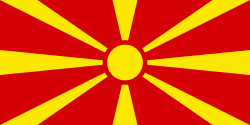Čegrane (Cegrane)
Čegrane (Чегране; Çegran) is a village in the municipality of Gostivar, North Macedonia. The village lies approximately 7 km east of the city of Gostivar. It has a population of about 4,000 inhabitants. Prior to merging with Gostivar Municipality, Čegrane was the seat of Čegrane Municipality.
At the beginning of the 19th century Čegrane was a predominantly Albanian village in Tetovo's Gostivarska Nahiya of the Ottoman Empire. According to the statistics of Vasil Kanchov (Macedonia. Ethnography and statistics), in 1900, Čegrane had 800 Muslim Albanian inhabitants. In 1913, the village came under the control of the Kingdom of Serbia along with the rest of Vardar Macedonia. According to the Russian Slavist Afanasij Selishchev in 1929, Čegrane was the center of municipality of five villages.
At the beginning of the 19th century Čegrane was a predominantly Albanian village in Tetovo's Gostivarska Nahiya of the Ottoman Empire. According to the statistics of Vasil Kanchov (Macedonia. Ethnography and statistics), in 1900, Čegrane had 800 Muslim Albanian inhabitants. In 1913, the village came under the control of the Kingdom of Serbia along with the rest of Vardar Macedonia. According to the Russian Slavist Afanasij Selishchev in 1929, Čegrane was the center of municipality of five villages.
Map - Čegrane (Cegrane)
Map
Country - Republic_of_Macedonia
 |
 |
The region's history begins with the kingdom of Paeonia, a mixed Thraco-Illyrian polity. In the late sixth century BC, the area was subjugated by the Persian Achaemenid Empire, then incorporated into the Kingdom of Macedonia in the fourth century BC. The Roman Republic conquered the region in the second century BC and made it part of the larger province of Macedonia. The area remained part of the Byzantine Empire, but was often raided and settled by Slavic tribes beginning in the sixth century of the Christian era. Following centuries of contention between the Bulgarian, Byzantine, and Serbian Empires, it was part of the Ottoman Empire from the mid-14th until the early 20th century, when, following the Balkan Wars of 1912 and 1913, the modern territory of North Macedonia came under Serbian rule.
Currency / Language
| ISO | Currency | Symbol | Significant figures |
|---|---|---|---|
| MKD | Macedonian denar | ден | 2 |
| ISO | Language |
|---|---|
| SQ | Albanian language |
| MK | Macedonian language |
| SR | Serbian language |
| TR | Turkish language |















